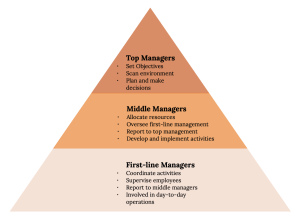8.1 Levels of Management: How Managers are Organized
Adapted by Stephen Skripak with Ron Poff
If you read our chapter on Management and Leadership, you will recall developing a strategic plan for your new company, Notes-4-You. Once a business has completed the planning process, it will need to organize the company so that it can implement that plan. A manager engaged in organizing allocates resources (people, equipment, and money) to achieve a company’s objectives. Successful managers make sure that all the activities identified in the planning process are assigned to some person, department, or team and that everyone has the resources needed to perform assigned activities.
Levels of Management: How Managers Are Organized
A typical organization has several layers of management. Think of these layers as forming a pyramid like the one in Figure 8.1, with top managers occupying the narrow space at the peak, first-line managers the broad base, and middle-managers the levels in between. As you move up the pyramid, management positions get more demanding, but they carry more authority and responsibility (along with more power, prestige, and pay). Top managers spend most of their time in planning and decision making, while first-line managers focus on day-to-day operations. For obvious reasons, there are far more people with positions at the base of the pyramid than there are at the other two levels. Let’s look at each management level in more detail.

Top Managers
Top managers are responsible for the health and performance of the organization. They set the objectives, or performance targets, designed to direct all the activities that must be performed if the company is going to fulfill its mission. Top-level executives routinely scan the external environment for opportunities and threats, and they redirect company efforts when needed. They spend a considerable portion of their time planning and making major decisions. They represent the company in important dealings with other businesses and government agencies, and they promote it to the public. Job titles at this level typically include chief executive officer (CEO), chief financial officer (CFO), chief operating officer (COO), president, and vice president.
Middle Managers
Middle managers are in the center of the management hierarchy: they report to top management and oversee the activities of first-line managers. They’re responsible for developing and implementing activities and allocating the resources needed to achieve the objectives set by top management. Common job titles include operations manager, division manager, plant manager, and branch manager.
First-Line Managers
First-line managers supervise employees and coordinate their activities to make sure that the work performed throughout the company is consistent with the plans of both top and middle management. It’s at this level that most people acquire their first managerial experience. The job titles vary considerably but include such designations as manager, group leader, office manager, foreman, and supervisor.
Let’s take a quick survey of the management hierarchy at Notes-4-You. As president, you are a member of top management, and you’re responsible for the overall performance of your company. You spend much of your time setting performance targets, to ensure that the company meets the goals you’ve set for it—increased sales, higher-quality notes, and timely distribution.
Several middle managers report to you, including your operations manager. As a middle manager, this individual focuses on implementing two of your objectives: producing high-quality notes and distributing them to customers in a timely manner. To accomplish this task, the operations manager oversees the work of two first-line managers—the note-taking supervisor and the copying supervisor. Each first-line manager supervises several non-managerial employees to make sure that their work is consistent with the plans devised by top and middle management.
Key Takeaways
- Managers coordinate the activities identified in the planning process among individuals, departments, or other units and allocate the resources needed to perform them.
- Typically, there are three levels of management: top managers, who are responsible for overall performance; middle managers, who report to top managers and oversee lower-level managers; and first-line managers, who supervise employees to make sure that work is performed correctly and on time.
Image Credits: Chapter 9
Figure 9.2: Unknown Author. “Adidas Geographic Divisions.” Data Retrieved from: https://report.adidas-group.com/2019/en/servicepages/downloads/files/adidas_annual_report_2019.pdf; Unknown Author (1991). “Adidas Logo.” Wikimedia Commons. Public Domain. Retrieved from: https://commons.wikimedia.org/wiki/File:Adidas_Logo.svg; Max Naylor (2006). “BlankMap-World-Continents-Coloured.” Wikimedia Commons. CC BY-SA 3.0. Retrieved from: https://commons.wikimedia.org/wiki/File:BlankMap-World-Continents-Coloured.PNG
Figure 9.3: Chrystine Angeline. “Manager.” Noun Project Inc. CC BY 3.0. Retrieved from: https://thenounproject.com/search/?q=manager&creator=2716563&i=1813155; Verry. “Female.” Noun Project Inc. CC BY 3.0. Retrieved from: https://thenounproject.com/term/female/2788855
Figure 9.5: Zntrip (2006). “Blank map of the United States.” GNU General Public License. Retrieved from: https://commons.wikimedia.org/wiki/File:Blank_map_of_the_United_States.PNG; Wiki-vr (2014). “Europe Blank Map.” Wikimedia Commons. Public Domain. Retrieved from: https://commons.wikimedia.org/wiki/File:Europe_blank_map.png
inputs used to produce outputs
are shorter-term performance targets that direct the activities of the organization toward the attainment of a goal
responsible for the health and performance of the organization. They set the objectives, or performance targets, designed to direct all the activities that must be performed if the company is going to fulfill its mission
They report to top management and oversee the activities of first-line managers. They’re responsible for developing and implementing activities and allocating the resources needed to achieve the objectives set by top management
supervise employees and coordinate their activities to make sure that the work performed throughout the company is consistent with the plans of both top and middle management

